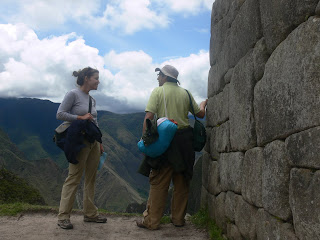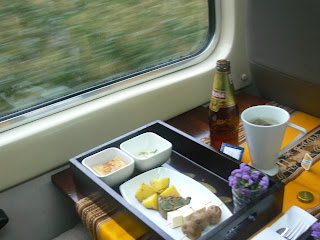We enjoyed a bit of a rest on Monday - just a quick evening trip to Miraflores, by the ocean - then headed downtown with Fredy around lunchtime on Tuesday. It seems that Lima has changed a whole lot over the past ten years, and the historical center has changed from a desolate and dirty place, to one replete with clean, vibrant plazas, pedestrian walkways and parks, and a brand new bus/metro. We wandered quite a bit, waiting for Eduardo to finish work, which gave us the chance to appreciate the range of beautiful architecture. There are lots of influences here, even to an ignorant eye like mine, including Art-Deco and touches of Arabian aesthetic by way of Spain. One prominent characteristic, dating from colonial times, can be seen in the elaborate balconies the adorn the older (and now-renovated) buildings.


Here you can see the fountain in the Plaza de Armas, where the militia used to gather, when called upon to defend the city, for example, when Chile stormed Lima over a century ago. (This was the same war in which Bolivia lost its coastline.) The fountain itself is very, very old, but continues to function well and, if Fredy and Eduardo are to be believed, runs with the national liquor, Pisco, instead of water during the Fiestas Patrias celebrations in July.

The Plaza de Armas is surrounded by lots of old, beautiful buildings, including the Palacio de Gobierno, where the President lives and works (way bigger than the White House), and the Archibishop's residence (below). Note the balconies...

After not too long, Eduardo met us for a delicious lunch at Tanta, the restaurant of a famous Peruvian chef, whose name I've forgotten. The cebiche - fish and other seafood marinated in lime and chile ("aji" in Peru), then served raw - was delicious, as was everything else we had. Erica ordered Seco de Res, a kind of roasted meat dish, and I had a Saltado, different types of marinated and grilled meats, served over tacu tacu, a seasoned and then fried mix of rice and canary beans. I like tacu tacu a lot.
Limeno food seems so far to be really diverse and realy delicious. Much of it is a fusion of various styles, including those Italy, Spain, Japan, China (Chinese food is called Chifa, from Mandarin for eat rice/food, and it is everywhere) and other regions of Peru. There are dozens and dozens of kinds of potatoes and related tubers and so, so many tropical fruits. Already we've tried four different kinds of bananas, two types of mangos and a few others whose names still haven't anchored in my brain. Should be fun!
Feed me!
After lunch, we visited the San Francisco cathedral and monastery, just a few blocks away. The original chapel on these grounds was built in 1546, just 11 years after Lima was founded, then destroyed in an earthquake in 1656. The cathedral you can see below, towering about the two of us and Fredy, was finished in 1672 and the monastery, in 1729.
Inside the cathedral/monastery is beautiful, filled with paintings, sculptures, woodwork and all sorts of religious accessories. The tour, boldly taken in Spanish instead of English, was great, although the photos below are borrowed from the web: cameras aren't allowed and we didn't have cellphones to snap pictures surreptitiously.
This is the library. Because the books were so flammable, candles weren't allowed. Light for reading came exclusively from the many skylights.
This ceiling was really striking - as were many throughout the buildings. Sorry the picture is so small, but it gives at least a sense of the intricate patterning and layering of the wood. I'd say the dome was about 25 feet across.

And underneath the cathedral . . . the catacombs! Until 1821, Lima had no cemetery, so most people who died in the city were buried in the labyrinthine tunnels under the San Francisco campus - around 25,000 Limenos in all, two to a grave. Much of the subterranean structure was damaged in subsequent earthquakes, but it is still in use as a final resting place for the remaining Franciscan monks. It was very much like being in an Indiana Jones movie (our second this trip!) and I had to be careful not to hit my head in quite a few places. It was well lit for the most part, but our tour guide said that she had been down there once when the lights went out for 6 or 7 minutes. She laughed it off, though, saying that so many of the tour group had cell phones that they were able to find there way around with no problem. The bones you see here were recovered during repairs and arranged for effect - that isn't how they were actually buried.

Just before heading back to Las Molinas, where we're staying, we swung through a new city park built around a part of the original town walls. There's a statue there that used to be more centrally located until they discovered that it wasn't actually a statue of Francisco Pizarro, Lima's founder, but Cortes, who was active much farther north, in Mexico. So the statue was relegated to a forgotten corner of this new park.



























